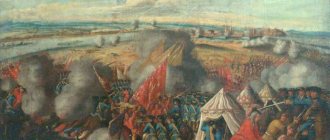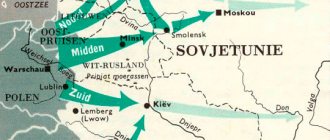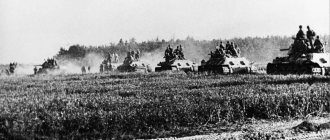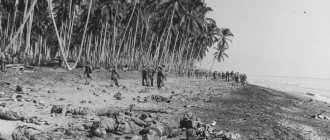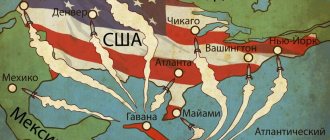Front on the eve of the battle
During the winter offensive of the Workers 'and Peasants' Red Army (RKKA) and the subsequent Wehrmacht counteroffensive in Eastern Ukraine, a protrusion up to 150 km deep and up to 200 km wide, facing west, was formed in the center of the Soviet-German front - the so-called Kursk Bulge. The German command decided to conduct a strategic operation to encircle and destroy Soviet units in the Kursk salient. For this purpose, a military operation codenamed “Citadel” was developed and approved in April 1943.
To carry it out, the most combat-ready formations were involved - a total of 50 divisions, including 16 tank and motorized divisions, as well as a large number of individual units that were part of the 9th and 2nd field armies of Army Group Center (commander General Field Marshal Günther von Kluge), to the 4th Panzer Army and Task Force Kempf of Army Group South (commander Field Marshal Erich von Manstein).
The group of German troops numbered over 900 thousand people, about 10 thousand guns and mortars, 2,245 tanks and assault guns, 1,781 aircraft.
By the beginning of the Battle of Kursk, the Soviet Central, Voronezh and Steppe fronts included more than 1.9 million people, more than 26 thousand guns and mortars, over 4.9 thousand tanks and self-propelled artillery units, and about 2.9 thousand aircraft. The troops of the Central Front under the command of Army General Konstantin Rokossovsky defended the northern front (the section facing the enemy) of the Kursk ledge, and the troops of the Voronezh Front under the command of Army General Nikolai Vatutin defended the southern front. The troops occupying the ledge relied on the Steppe Front, consisting of rifle, three tank, three motorized and three cavalry corps (commander - Colonel General Ivan Konev). Soviet units had a powerful layered defense, rich in anti-tank weapons. The actions of the fronts were coordinated by representatives of the Headquarters of the Supreme High Command, Marshals of the Soviet Union Georgy Zhukov and Alexander Vasilevsky.
Losses of Soviet and German armored vehicles in 1943. Kursk Bulge
Why the T-34 lost to the PzKpfw III, but won against the Tigers and Panthers.
In 1941, the "thirty-four" had extremely powerful armor and a cannon compared to any armored vehicles of Nazi Germany. However, these advantages were largely balanced by the well-known “blindness” - the lack of surveillance equipment, the lack of a fifth crew member, the complexity of control, as well as a host of “childhood diseases.” In addition, on average, Soviet tank crews were prepared noticeably worse than German ones, who gained combat experience in Poland and France, and units and formations were inferior both in experience and in communications, and the ability to competently combine the actions of infantry, artillery and tanks.
In 1942, the superiority of the T-34 in artillery and armor remained, while the tank gradually got rid of “childhood diseases”, and the tank troops gained much-needed combat experience. But the Germans did not sit idly by, and by the end of the year they were able to supply the troops with long-barreled 50-mm and 75-mm guns, which they also began to arm their tanks and self-propelled guns with. This created certain inconveniences for the Germans, but as a result, by the beginning of 1943, the T-34 lost the honorary title of a tank with anti-ballistic armor.
In the first half of 1943, the T-34 finally received the most important upgrades, such as high-quality air filters, a commander's cupola, a new gearbox, etc., which turned the T-34 into a very advanced tank for maneuver warfare and deep operations. According to the author, which he justified in the previous article, based on the totality of the combat qualities of the T-34 mod. 1943 was quite consistent with the German T-IVH medium tank. The Thirty-Four, of course, was inferior to the Four in a head-on duel situation, because the very powerful 75-mm cannon of the German tank and the partial armoring of the frontal projection of the hull with 80 mm armor gave it undeniable advantages in such a battle. However, even in such a situation, the superiority of the German tank was not absolute, since its turret and part of the frontal projection of the hull could well have been penetrated by solid armor-piercing “blanks” of the T-34. However, the war is not at all limited to head-on tank combat, and in many other aspects the T-IVH was inferior to the T-34 - due to the weak armor of the sides, top of the hull and bottom, it was much more vulnerable to the effects of small-caliber anti-tank artillery, as well as field artillery, infantry anti-tank weapons and mines. At the same time, the T-34 had a greater range on one refueling, and finally became a fairly reliable and relatively easy-to-operate tank, suitable for deep operations.
Thus, we can say that from about June 1943, the T-34 with a 76.2 mm cannon reached the peak of its development.
By the beginning of 1943, the troops received a very significant number of “thirty-fours”. In total, at the beginning of this year, the Red Army had 7.6 thousand medium tanks, and it is obvious that the bulk of them were T-34s of various years of production. A very large figure, taking into account the fact that the Germans’ total number of armored vehicles at the beginning of the same year reached about 8 thousand units, which included light vehicles, and not all of them were on the eastern front. During 1943, the army received 23.9 thousand medium tanks, including approximately 15.6 thousand “thirty-fours”. In total, in 1943, the factories produced 15,696 of these tanks, but perhaps not all of those produced managed to get into units, but a certain number of “thirty-fours” produced in 1942 could have been transferred to them. However, this will not seriously affect the statistics .
Thus, we can state that the situation in the tank forces has improved in all respects - here is mass production, qualitative improvement of tanks, and improvement of staff structures, in the form of the formation of tank and mechanized corps of a completely adequate composition, and on their basis - tank armies . The former can be considered an analogue of German tank and motorized divisions, the latter - tank corps. In addition, of course, the soldiers and commanders gained rich military experience.
Loss ratio in 1943
And yet, our tank losses in 1943 significantly exceeded the German ones.
If we take the statistics presented by Müller-Hillebrand, it turns out that the Panzerwaffe this year on all fronts irretrievably lost 8,988 tanks and self-propelled guns of all types. At the same time, the losses of the Red Army amounted to about 23.5 thousand tanks and self-propelled guns. As mentioned earlier, the figures given are not equivalent, since the Wehrmacht and the Red Army recorded losses differently. Our irretrievable losses include both non-combat losses and part of the returnable losses, in cases where a disabled tank required major repairs or restoration. And here it remains to blame the inaccuracies of historians. For example, G.F. Krivosheev, in the book “The Great Patriotic War. The Book of Losses" indicates that the losses of Soviet armored vehicles shown in the table below are irrevocable
But he also points out that the column “Received” takes into account the receipt of armored vehicles from factories, Lend-Lease and those returned to the troops from overhaul and after restoration. At the same time, regarding the loss column, it is indicated that it contains both combat and non-combat losses. But it is quite obvious that “Losses” also include tanks that left for major repairs or restoration, since otherwise the balance simply would not balance out.
Well, the Germans don’t have any of this, or if they do, it’s far from complete. Why? If we try to balance the Muller-Hillebrand figures, we will see that the balance does not go both ways: that is, for some tanks the calculated balances are lower than the actual ones, for others they are higher. It is possible that these are simply inaccurate numbers, but most likely this is a consequence of the lack of accounting for the disposal and return of armored vehicles from major repairs.
Müller-Hillebrand says nothing about the losses of captured tanks, and there were many of them in the German troops even on the Kursk Bulge. Accordingly, when recalculated according to the German method, Soviet losses of tanks and self-propelled guns will significantly decrease, and vice versa - calculation according to the Soviet method will lead to a significant increase in German losses.
All this is true, but for a correct comparison it is necessary to take into account other factors - now “in favor” of the Germans. In 1943, their troops fought very fierce battles in Africa, and then capitulated in Tunisia, which, naturally, led to noticeable losses, including in tanks. And then there was the landing in Sicily and other battles, in which the Germans, naturally, also suffered losses in tanks - and all this should be subtracted from the total number of losses, since, for comparison, we only need those losses that the Germans suffered in the Soviet Union. German front. In addition, in one of the previous articles in this series, the author made a very reasonable assumption that in 1943 a significant part of the losses of the Panzerwaffe, which they actually suffered earlier, during 1942 in the Battle of Stalingrad, were taken into account.
Thus, finding out a somewhat reliable ratio of losses of tanks and self-propelled guns of the USSR and Germany on the Soviet-German front is an extremely difficult, if not impossible, task. But in any case, it can be stated that the Red Army lost much more tanks and self-propelled guns than the Wehrmacht and SS. The loss ratio of 2:1 is probably close to the truth, but it is possible that things were even worse for the Red Army.
And here, of course, a natural question arises: if the organization, combat experience and materiel (in the form of the T-34) of the Soviet tank forces came very close to the German Panzerwaffe, then where does such a difference in losses come from?
Two words about the Kursk Bulge
The Kursk Bulge and its individual episodes, such as the Battle of Prokhorovka, still remain the subject of fierce debate among military history buffs. And one of the reasons for such a dispute is the irretrievable losses of tanks and self-propelled guns that the parties suffered.
Of course, it is absolutely impossible to give an exhaustive assessment of Soviet and German armored vehicle losses in the format of a magazine article, but still some observations are worth making. More or less balanced estimates give a ratio of 4:1 in favor of the Germans - a number of sources call irrecoverable losses of 6,000 tanks and self-propelled guns for us and 1,500 for the Panzerwaffe. Where did these numbers come from?
According to G.F. Krivosheev, in the Kursk defensive, Oryol and Belgorod-Kharkov offensive operations carried out during July-August 1943, the Red Army lost 6,064 tanks and self-propelled guns. Müller-Hillebrand reports that the total irretrievable losses of Wehrmacht equipment in July-August amounted to 1,738 vehicles. Of course, the places in which the Germans lost their tanks were not at all limited to these three operations, since in the same August the Donbass, Donetsk and Chernigov-Poltava operations began, and our allies invaded Sicily, but still the main losses were in armored vehicles, Of course, the Germans suffered precisely at Kursk. In addition, the factor of the late write-off of fascist tanks for scrap played a role here again (they were often transferred in the accounting to the column “requires major repairs” and were written off only later, as noted by a number of domestic and foreign researchers). Again, one should remember the incomparability of the numbers - 6,064 tanks and self-propelled guns for G.F. Krivosheev received equipment that had left for major repairs and restoration.
And then the questions begin. The fact is that the battle on the Kursk Bulge for us consisted of 3 battles listed above: Kursk defensive, Oryol and Belgorod-Kharkov offensive. The Germans, by Operation Citadel, essentially understood only part of the Kursk defensive operation. The latter lasted 19 days, from July 5 to July 23, 1943: the Germans understand Operation Citadel only from July 5 to July 17. If we assume that the Wehrmacht and SS lost 1,500 tanks and self-propelled guns irretrievably in all three operations, then it is obvious that their losses during Operation Citadel were significantly lower.
And here a big stumbling block arises between a number of sources, as well as our official history and the revisionists. Previously, it was generally accepted that German units were drained of blood during the Citadel and lost their combat effectiveness for a long time. This is confirmed by such an eminent German author as Kurt Tippelskirch, who, after describing the attempts to “cut off” the Kursk ledge, points out: “Within a few days it became clear that the German troops, having suffered irreparable losses, were unable to achieve their goal.”
However, revisionists see the issue differently. They indicate that the Germans, according to various sources, concentrated 2,500 - 2,700 tanks and self-propelled guns, or even a little more, for Operation Citadel. At the same time, the irretrievable losses in armored vehicles during the operation amounted to several hundred vehicles at most. For example, according to German researchers Zetterling and Frankson, who worked in the archives of Germany, the irretrievable losses of Army Group South advancing on the southern front from July 5 to July 17 amounted to only 172 tanks and 18 self-propelled guns, that is, only 190 vehicles. This is confirmed by the German General Heinrici, indicating irretrievable losses of 193 vehicles.
However, our compatriot A.S. did not agree with such assessments. Tomzov, who personally arrived at the archives of Germany and studied German documents. Unlike Zetterling and Frankson, he took into account the fact that the Germans often first gave damaged armored vehicles the status of “requiring major repairs”, and wrote them off as scrap only later. Having traced the “fate” of German tanks, he came to the conclusion that, taking into account the later decommissioned vehicles, the real irretrievable losses of armored vehicles of Army Group South in the period from July 5 to 17 were not 190-193, but 290 vehicles, that is, real irretrievable losses the Germans were approximately one and a half times higher than calculated.
But even if we take the figure of 290 tanks as a basis, it still turns out that the Soviet troops only managed to scratch the tank units of Army Group South, which, according to the most minimal estimate, numbered about one and a half thousand tanks and self-propelled guns. After all, it turns out that irretrievable losses amounted to no more than 20% of their original number!
And this, according to the revisionists, indicates that in fact, during Operation Citadel, the German Panzerwaffe did not suffer significant damage, and the Germans stopped the operation solely under the influence of the Allied landing in Sicily and the need to transfer tank units to Italy. This is also confirmed by the fact that the “defeated” German tank forces subsequently, in the same 1943, fought very effectively against the advancing Soviet troops. And this same point of view is confirmed by such a prominent German military leader as E. Manstein, who reports that the German troops under his command were quite capable of completing the “Citadel”, and if not achieving complete success with the encirclement, then at least defeating the Soviet forces opposing them army, and if not for Hitler, who ordered the withdrawal of troops...
Who is right?
Oddly enough, but, according to the author of this article, both the revisionists and the “traditionalists” are right at the same time.
Most likely, the revisionists are absolutely right that the irretrievable losses of German armored vehicles during Operation Citadel (that is, from July 5 to July 17) are relatively small. But they completely mistakenly believe that the combat effectiveness of tank forces is determined by the irretrievable losses of tanks and self-propelled guns. In fact, of course, the combat effectiveness of tank forces in terms of materiel is determined not by their irretrievable losses, but by how much equipment remains in service. And here the Germans were not doing too well, because the same General Heinrici cites data that in Operation Citadel the German army lost 1,612 tanks and self-propelled guns, of which 323 were irretrievable. Taking into account the fact that the Germans, according to various sources, had from 2,451 to 2,928 units at the beginning of the operation. armored vehicles (it is interesting that the upper limit is not given by Soviet historiography, but by Glanz), it turns out that by July 17 they had 35-45% of their units left in combat-ready condition. armored vehicles from the original number. And if we take the most common figure of 2,700 cars as a basis, then 40%. Generally speaking, according to the rules of military science, a formation that has suffered losses of more than 50% is considered defeated.
Thus, the irretrievable losses of the Germans are really small - from 323 to 485 vehicles, if the amendment of the respected A.S. Tomazova is also correct for the 9th Army, which was advancing from the north, and that the real irretrievable losses were approximately one and a half times higher than what appeared from operational German reports. But it is equally true that by July 17, the Wehrmacht tank units had suffered heavy losses and had largely lost their offensive potential.
What about the Red Army?
Losses of the Soviet army during the Kursk defensive operation by G.F.
Krivosheev’s total was 1,614 “irretrievable” tanks, that is, this figure includes both combat and non-combat losses, as well as not only destroyed tanks, but also those requiring major repairs. That is, logically speaking, if we compare Soviet and German tank losses, then the figures of 1,614 Soviet tanks versus 1,612 German tanks give a much more accurate picture than 1,614 versus 323-485 units. irretrievably lost German tanks and self-propelled guns. Of course, such a comparison will also not be correct, because in 1,612 units. German losses include vehicles that are out of order but do not require major repairs, and those are not taken into account in the 1,614 tanks and self-propelled guns of the USSR. On the other hand, we must not forget that the USSR lost 1,614 tanks between July 5 and July 23, and German losses were limited to July 17.
But in any case, one can be sure of one thing - although the Soviet losses of tanks and self-propelled guns (irrecoverable plus returnable ones) during Operation Citadel may have been somewhat greater than the German ones, but not by several times, and certainly not by orders of magnitude. They were quite comparable, despite even individual gross mistakes by the military leaders of the Red Army, which led to heavy losses. The largest of these mistakes was the battle of Prokhorovka, which took place on July 12 and led to unreasonably high losses of Soviet tanks.
Irreversible losses of armored vehicles as an indicator of ability to fight
It's absolutely no good, and here's why.
Taking as a basis the level of irretrievable losses from their total level according to General Heinrici, or according to updated data according to A.S. Tomazov, we see that the Germans in Operation Citadel irrevocably lost 20-30% of the total level of armored vehicle losses. This is exactly the number of 323-485 “irretrievable” tanks and self-propelled guns for the total number of German losses of 1,612 vehicles. It can be assumed that in other battles the percentage of irretrievable losses of German tanks was at the same level, that is, 20-30% of the total number of irretrievable and returnable losses. At the same time, the irretrievable losses of Soviet armored vehicles averaged 44%, and in some operations in 1943-44. could reach 65-78%.
Dear readers, you probably already understand what’s going on here. Let's imagine that a German tank division and a Soviet tank corps entered the battle for the possession of a certain village of New Vasyuki. Both of them were pretty battered in previous battles, and retained 100 tanks and self-propelled guns. The battle went on all day, and by the evening the sides retreated to their original positions, while both the Soviet and German formations lost 50 tanks destroyed.
What conclusions can be drawn from the results of such a battle? Obviously, the battle ended in a draw. Both sides failed to complete the combat mission, but at the same time prevented the enemy from doing so, and suffered equal losses. This means that we can say that the Soviet corps and the German division demonstrated approximately equal martial art.
But out of 50 destroyed Soviet tanks, 20 were completely destroyed, and out of 50 German tanks, only 10. That is, the irretrievable losses of Soviet and German armored vehicles are related as 2:1. This is how it turns out that, although in reality the sides were equal in their fighting qualities, an assessment of irretrievable losses will show that the German division fought twice as well as the Soviet corps!
The same is the case with the Battle of Kursk. When a person interested in military history sees the ratio of irretrievable losses roughly 4:1 in favor of the Panzerwaffe, he will naturally draw the conclusion about the overwhelming superiority of the material and skill of Hitler's troops. But if we dig a little deeper, we will see that the ratio of irretrievable losses was in fact not four to one, but significantly better for the Soviet troops, and the overall level of losses gives a completely different ratio. And therefore we need to understand that when we look at the ratio of irretrievable losses for any period of hostilities, or in a specific battle, then we see... precisely the ratio of irretrievable losses, but not the ratio of the combat qualities of the parties.
But still, why did the Soviet irretrievable losses of armored vehicles in the total losses amount to 44%, and the German ones - about 30%, that is, one and a half times less? We will talk about this in the next article.
Progress of the battle
On July 5, 1943, German attack groups launched an attack on Kursk from the Orel and Belgorod areas. On July 12, during the defensive phase of the Battle of Kursk (Kursk strategic defensive operation July 5-23), the largest tank battle in the history of the war took place on the Prokhorovsky field. Up to 1,200 tanks and self-propelled guns simultaneously participated in it on both sides. In fierce battles, the Wehrmacht troops lost up to 400 tanks and assault guns, went on the defensive, and on July 16 began to withdraw their forces. On July 12, the second stage of the Battle of Kursk began, the counter-offensive of the Soviet troops: the Oryol strategic offensive operation "Kutuzov" (July 12 - August 18) and the Belgorod-Kharkov strategic offensive operation "Rumyantsev" (August 3-23). During the Battle of Kursk, Operation Rail War was carried out in the rear of German troops by partisan formations. Its goal was large-scale sabotage at railway facilities to impede the transfer of supplies and reinforcements by the Germans, as well as to pull back some of the forces to protect supply routes and counter partisans.
On August 5, as a result of Operations Kutuzov and Rumyantsev, Oryol and Belgorod were liberated. On the evening of the same day in Moscow, in honor of this event, an artillery salute was fired for the first time during the war. On August 23, Kharkov was liberated. Soviet troops advanced 140 km in the southern and southwestern directions and took an advantageous position for launching a general offensive to liberate Left Bank Ukraine and reach the Dnieper. The German command finally lost the strategic initiative and was forced to go on the defensive along the entire front.
In one of the largest battles in the history of World War II, more than 4 million people took part on both sides, about 70 thousand guns and mortars, more than 10 thousand tanks and self-propelled guns, and about 11 thousand combat aircraft were involved.
Tank battle near Prokhorovka
On July 12, southwest of Prokhorovka, the Germans launched an offensive. The command of the Voronezh Front sent here the 5th Guards Tank Army with two attached tank corps and the 33rd Guards Rifle Corps a little earlier. One of the largest tank battles in the entire history of World War II took place here (09/01/1939 – 09/03/1945). To stop the advance of the 2nd SS Tank Corps (400 tanks), the corps of the 5th Guards Tank Army (800 tanks) were thrown into a frontal attack. Despite the seemingly large advantage in the number of tanks, the 5th Guards Tank Army was inferior in their “quality.” It consisted of: 501 T-34 tanks, 264 light T-70 tanks and 35 heavy Churchill III tanks with low speed and insufficient maneuverability. Our tanks could not compare with the enemy in striking range. To knock out the German Pz. VI "Tiger" our T-34 tank needed to approach at a distance of 500 meters. The Tiger itself with 88 mm. with a cannon he effectively fought a duel at a distance of up to 2000 meters.
It was possible to fight in such conditions only in close combat. But it was necessary to shorten the distance in some incomprehensible way. Despite everything, our ordinary Soviet tank crews survived and stopped the Germans. Honor and praise to them for this. The price of such a feat was very high. Losses in the tank corps of the 5th Guards Army reached 70 percent. Currently, Prokhorovskoe Field has the status of a museum of federal significance. All these tanks and guns are installed here in memory of the Soviet people who, at the cost of their lives, turned the tide of the war.
Part of the exposition of the Prokhorovskoe Field memorial
Results of the battle
After the victory in the Battle of Kursk, the strategic initiative finally passed to the side of the Red Army, and the Germans lost the opportunity to conduct offensive operations. During the Battle of Kursk, Soviet troops defeated 30 German divisions (including seven tank divisions). Enemy losses amounted to 500 thousand killed, wounded and prisoners (according to the Great Russian Encyclopedia, 2010). According to calculations by a research team led by Colonel-General Grigory Krivosheev, a consultant at the Military Memorial Center of the Russian Armed Forces, the total irretrievable losses of the Soviet armed forces in the Kursk, Oryol and Belgorod-Kharkov operations in the period from July 5 to August 23, 1944 amounted to 254,470 people, the total sanitary losses - 608,833 people.
Battle of Kursk. Going on a counteroffensive
After this, the Germans were largely bled dry, losing their offensive potential. But the Soviet reserves, on the contrary, had not even been brought into action yet and were ready to launch a counter-offensive. And it began - almost without pause after the end of the defensive phase of the operation.
The counteroffensive unfolded on a front exceeding six hundred kilometers; Troops from five fronts were thrown into it, with the depth of operations to complete the assigned tasks up to 180 kilometers.
Battle of Kursk map
The Germans were knocked out of the Oryol bridgehead, and they were forced to retreat to the Hagen defensive line, prepared in advance, located east of Bryansk. The cities of Orel and Belgorod were completely liberated from the invaders on August 5. On this occasion, by personal order of Stalin, the first festive artillery salute in all the years of the war was given in Moscow. (Kursk had already been liberated by the Red Army in February 1943).
Perpetuation of memory
For their exploits in the Battle of Kursk, more than 180 soldiers and officers were awarded the title of Hero of the Soviet Union, over 100 thousand people were awarded orders and medals. About 130 formations and units received the guards rank, more than 20 were awarded the honorary titles of Oryol, Belgorod, and Kharkov.
For their contribution to the victory in the Great Patriotic War, the Kursk region was awarded the Order of Lenin, and the city of Kursk was awarded the Order of the Patriotic War, 1st degree. In 1983, the feat of Soviet soldiers on the Kursk Bulge was immortalized in Kursk - on May 9, a Memorial was opened in memory of those killed during the Great Patriotic War. On May 9, 2000, in honor of the 55th anniversary of the victory in the battle, the Kursk Bulge memorial complex was opened. On April 27, 2007, by decree of Russian President Vladimir Putin, Kursk was awarded the honorary title of the Russian Federation “City of Military Glory”.
Klim high-speed
The heavy KV-1 (Klim Voroshilov-1) was the most powerful tank in the world before the advent of the Panthers and Tigers. The Germans called him Gespenst - "Ghost".
But there were reports from the troops about its lack of mobility, and there were complaints about the gearboxes and sights.
The situation with the defective gearbox acquired such proportions that in the spring of 1942, a commander with a terrible reputation was sent to the Crimean Front: Army Commissar 1st Rank Lev Mehlis. Joseph Kotin, one of the fathers of the KV, also went to the troops.
But the main problem is the engine. Attempts to boost the existing one - from 600 to 650 hp. — were unsuccessful, the engine overheated. But it was not possible to replace it with a new one during the war.
The generals looked at the situation from “their bell tower.” And they reported to Stalin that the KV was destroying bridges and breaking up roads. And most importantly, the gun on the heavy Klim and the medium T-34 is the same.
Measures have been taken. The designers reduced the weight to 42.5 tons. The KV-1S tank was tested both here and in the USA. There were some comments (there are no perfect tanks), but overall the results were positive. The weapon remained the same: 76.2 mm ZiS-5 cannon. Maneuverability has improved, speed has increased: from real 28 km/h (according to the passport 34 km/h) to 43 km/h. Actually, the “C” in the name speaks of the speed qualities of the new tank. But the thickness of the armor had to be sacrificed somewhat.
It went into production in August 1942. KV-1S tanks distinguished themselves at Stalingrad and performed well in the Kursk operation. But a good tank found itself in a difficult niche. It had equal armament with the T-34, superior to the latter in armor, but inferior in mobility. And it was more difficult and expensive to produce. And when a powerful 85-mm cannon was installed on the T-34, the management considered that the advantages of a heavy tank over a medium one were lost.
KV-1 was deciphered by knowledgeable people: Kotin to Voroshilov
Well, personal factors, where would we be without them. Stalin somewhat disliked this tank. His phrase went down in history: “The T-34 walks well in deep snow, like a swallow flies, but the KV does not.” Actually, this applied to the KV tank without the letter “C”. But objectively, the heavy KV-1S was not a swallow compared to the medium T-34.
By the way, knowledgeable people deciphered the name of the tank: Kotin - Voroshilov. Joseph Kotin was married to the daughter of the legendary marshal. But even such names did not change the fate of the extraordinary car. In September 1943, the KV-1S was discontinued (having produced 1,200 vehicles) in favor of the IS-1.
Stalin was afraid to both attack and defend
There was also no unanimity among the Soviet generals. Thus, the commander of the Voronezh Front, General Nikolai Vatutin, believed that it was necessary to attack. And his colleague, General Konstantin Rokossovsky, who led the Central Front, on the contrary, believed that it was necessary to go on the defensive in order to exhaust the enemy and knock out his tanks, and only then, introducing fresh forces, launch a general offensive and defeat the main enemy group. And Deputy Supreme Commander-in-Chief Marshal Georgy Zhukov and the leadership of the General Staff of the Red Army were in solidarity with him.
Stalin himself always preferred an active, offensive war, but the opinion of the majority of military leaders forced him to agree to defensive tactics.
There was another serious argument in favor of Rokossovsky’s proposal - the leader remembered very well that the offensives last year, 1942, did not bring success to the Red Army either during the battles for the Kerch Peninsula, or during the spring Kharkov operation, or in the protracted bloody battles for Rzhev.
On the other hand, Stalin seriously feared that the defense of the Red Army might not withstand attacks from German tank forces, as was the case in 1941 and 1942.
Vatutin and Rokossovsky: different tactics
Rokossovsky relied on the mobility of the defense, concentrating almost all tank formations, up to 70% of artillery and more than 50% of rifle divisions in the most dangerous directions.
Vatutin on the Voronezh Front chose to evenly distribute infantry and artillery along the entire front line, digging his tanks into the ground, that is, essentially turning them into long-term artillery firing points. But depriving himself of tank “fists”.
At the same time, Rokossovsky united all anti-tank strong points into anti-tank areas and subordinated them to the commanders of rifle regiments. During the battle, such close interaction between the two branches of troops had a beneficial effect in repelling German attacks.
Soviet artillerymen move a 45-mm anti-tank gun for direct fire during the fighting on the Kursk Bulge
But on the Voronezh Front, the Headquarters representative, Marshal Vasilevsky, forbade Vatutin to subordinate the assigned artillerymen to the infantry. As a result, the anti-tank crews were left to their own devices, often not knowing what was happening with their neighbors and seeing only their own defense sector. On the Central Front, the representative of the Headquarters, Marshal Zhukov, did not interfere with Rokossovsky’s orders.
At the same time, Moscow overestimated the danger to the northern front of the Kursk Bulge, believing that the Germans would deliver the main blow on the Central Front in order to break through it and turn towards Moscow. Therefore, Rokossovsky had slightly more units than Vatutin.
Vatutin almost forced Stalin to attack first
For three months, Soviet troops tensely awaited the German offensive day after day. At first, the General Staff reported that it was expected on May 10-12, then the deadline was pushed back to May 26. The military leaders were growing impatient. In particular, Vatutin repeatedly asked Stalin and the Chief of the General Staff, Marshal Vasilevsky, to attack first. He feared that the whole summer would pass in such passive anticipation and that Soviet plans for 1943 would fail.
Stalin hesitated. Vatutin insisted that the first blow must be struck no later than the first days of July. As a result, the Supreme Commander-in-Chief ordered the general to report his thoughts to the General Staff. However, the majority of military leaders again did not support the idea of an offensive. It was decided not to change plans for the summer campaign.
General Nikolai Vatutin
On the morning of July 5, 1943, Rokossovsky called Stalin and happily reported that the Germans had launched an offensive.
-What are you happy about? – he was surprised.
- Now victory will be ours, Comrade Stalin! - replied the commander of the Central Front.

